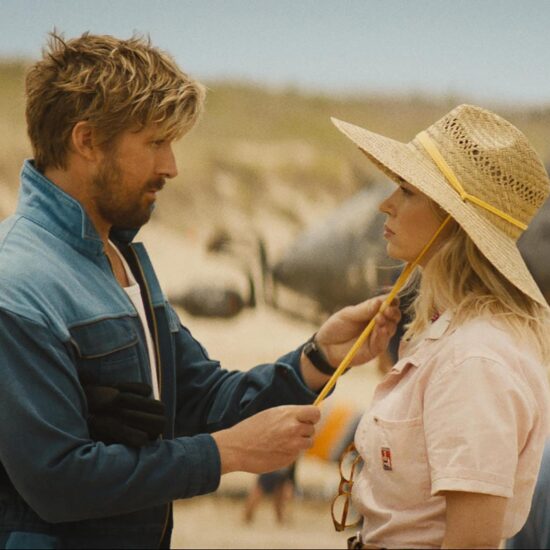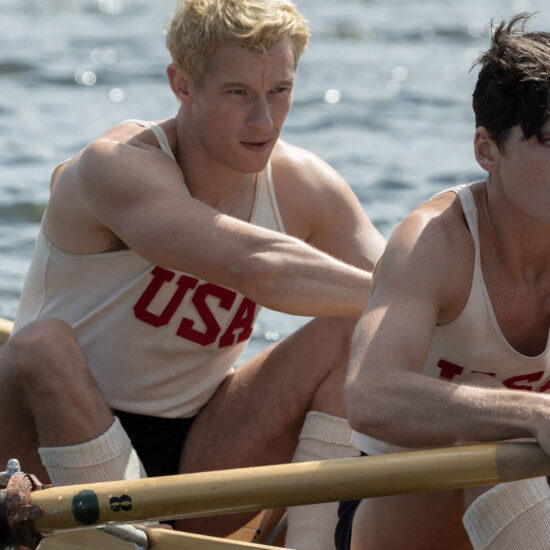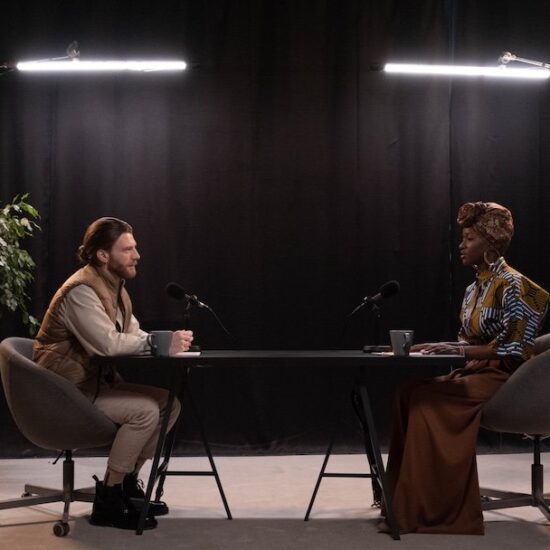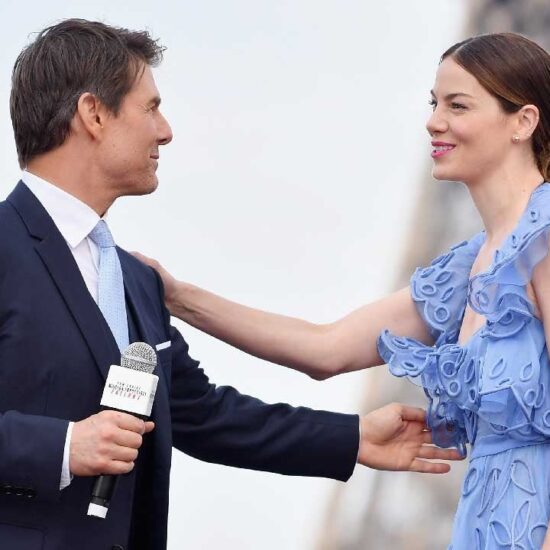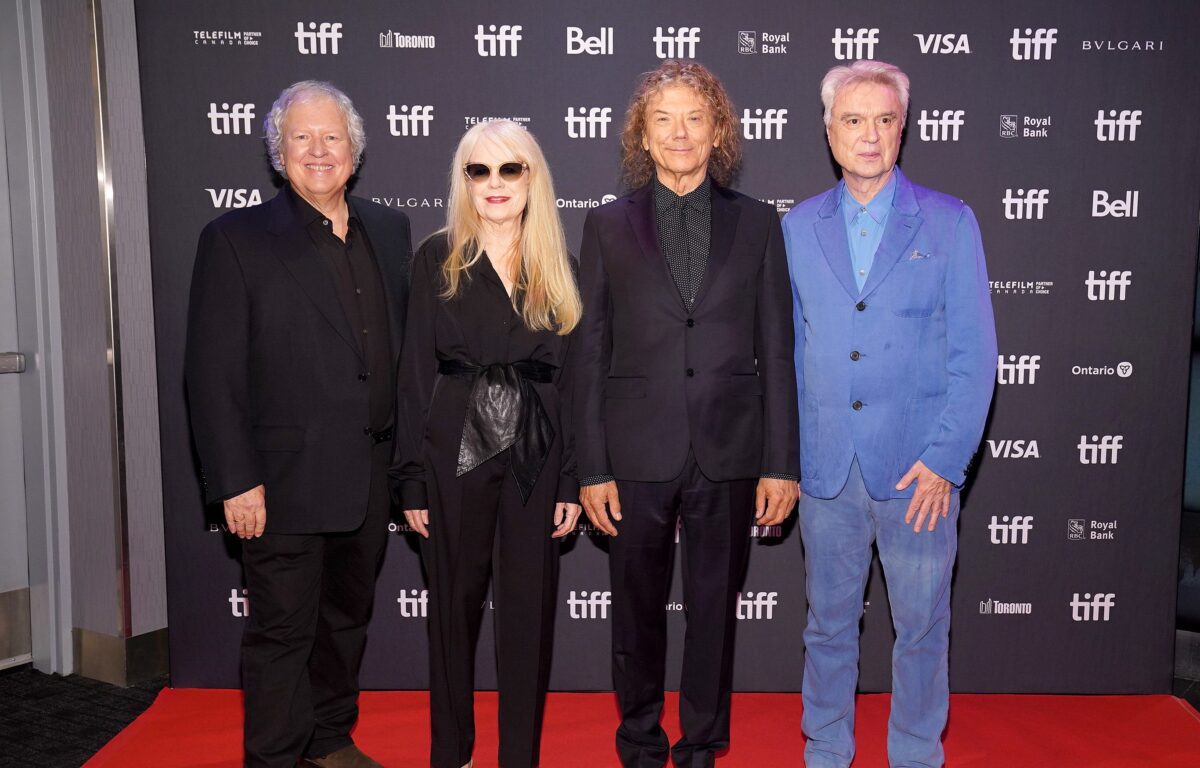
Watching “Stop Making Sense” in 4K IMAX at the 2023 Toronto International Film Festival was a transporting, immersive, joyous experience. Some of us also saw the 1983 Talking Heads concert tour promoting their fifth album, “Speaking in Tongues”; when Jonathan Demme saw the show, the director asked if he could document the concerts. The band, which admired Demme films such as “Caged Heat” and “Melvin and Howard,” loved the idea.
Demme shot the film over three performances in December 1983 at the Pantages Theater in Los Angeles. Four months later, it was in theaters and grossed $5 million. Forty years later, the band holds the film rights. They worked with A24 to release the restored 4K version for its exclusive IMAX run on September 22 before heading to conventional theaters September 29 around the world.
At the Toronto world premiere, even the band rose up in their vertiginous IMAX seats and danced — who could resist “Road to Nowhere,” “Once in a Lifetime,” and “Take Me to the River,” not to mention “Burning Down the House”? At the press conference hosted by Byrne’s “American Utopia” director Spike Lee, Talking Heads reunited for the first time since their induction to the Rock ‘n Roll Hall of Fame in 2002. “It seemed like [the show] had a progression to it, a story,” said David Byrne. “And it occurred to us, ‘This could maybe work as a film. It’s got a beginning and a middle and an end.’”
In fact, the movie serves as a kind of band history, from opening on a bare stage with Byrne accompanying himself on acoustic guitar for “Psycho Killer” — the song from “77” that propelled the band to stardom — to adding bassist Tina Weymouth, drummer Chris Frantz (her husband), and guitarist Jerry Harrison, who later joined the band. From there, it’s the late great piano player Bernie Worrell, percussionist Steve Scales, backup singers Lynn Mabry and Ednah Holt, and guitarist Alex Weir.
Byrne created the stage narrative. “It’s a greatest hits and a history and the development of the band up to that point,” he said. However, Weymouth pointed out that it’s a false narrative. Byrne and Frantz started playing together when they were students at the Rhode Island School of Design in a band called The Artistics. “And I didn’t join until almost two years later,” she said. “And then Jerry joined two years after that. So it’s not completely accurate as a story, but it works really well.”
“Never let the truth interfere with a good story,” said Frantz.
I spoke to the band about creating the concert classic and why it was possible to transform the analog original into a 4K digital movie with enough resolution to blow up to IMAX — beautifully.
The concert was already staged and choreographed: Talking Heads were a well-oiled machine
All Demme and his crew had to do was film what was before them, as effectively as possible. “A lot of people tend to think that Jonathan, being a director, shaped what we were doing to make it into a movie,” Byrne told me on Zoom. “But he did an incredible job capturing what we were doing.”
The tour had been going on since the beginning of the year. “It was long and drawn out,” said Weymouth. “But we were having fun doing this every single night. And the important thing was capturing what we were doing without interfering with what we were doing.”

Demme knew how to delegate and organize
Demme, who was distracted by reshoots on another movie, “Swing Shift,” sent in the visual consultant Sandy McLeod, who traveled with the band for a couple of months. “She took copious notes of everything,” said Weymouth. “So she already had the shots all mapped out. Jonathan’s gift is he was a great team leader. He could delegate to different people who had their expertise. And everybody got along really well.”
The first night was a rehearsal that allowed the camera crew to learn where and how the band moved and interacted during the show. For the second, third, and fourth nights, they added audio recording and filmed the show with six cameras including steadicams. “Then the editor, Lisa Day, married the two separate parts, audio and film together,” said Weymouth. “Jonathan always saw the human qualities of people, and in the show you see the different players as characters of a strange little a narrative that makes you scratch your head. We had our crew, we had our band, we had everything working very, very well. We had lighting, rigging. Then they came in with all of their equipment and we got used to that rapidly and just carried on as we would normally.”
Challenges remained: The 35mm film cameras had to be reloaded every 15 minutes or so. On the first night, the house lights were turned too high; it made the audience shy. On subsequent nights production turned them down and the excitement level went back up.
Jerry Harrison insisted on digital audio
It was early days for digital recording of audio. “The digital recording machines were in Houston, Texas,” said Byrne. “They didn’t have them in LA, which is kind of amazing.” 3M invented digital recording for Navy submarines, Harrison said, “for trying to boost levels to listen to where the Russian submarines were. Then the technology spread. Sony had just come out with their multitrack. This guy, Jim Moran down in Texas, was the only person who had two of them, because we needed to be able to bounce back and forth between them. The film requires re-recording; by using digital, we weren’t going down a generation every time we re-recorded. That’s why it was essential.”
It also was essential for the IMAX restoration. Harrison worked with producer Gary Goetzman on the technical aspects of the restoration, which included a long search for the negative that turned up in a Kansas warehouse.

“There were questions of the different things that you can do when you’re bulking up to IMAX,” said Harrison, “and the question of what’s the right amount of those sort of enhancements that you can do. It largely has to do with: How much of the grain are you enlarging? Or do you try and do things to smooth it out a little bit? What we just saw on IMAX in Toronto, we got it just right. We didn’t do too much — we didn’t make it look sort of flat or like a video. The look still has the characteristics that it had back in ’84, but it has the added clarity that we were able to give it now.”
Talking Heads created memorable staging and choreography
While Bryne staged the show, the choreography emerged from rehearsals. If something worked, they kept it. An unforgettable aspect of the show was Byrne’s giant suit (Spike Lee called it a “fat suit”). He changes into it while Frantz and Weymouth performance of “Genius of Love,” the big hit from their side project Tom Tom Club. They weren’t entirely keen on playing the song, but it was crucial to give Byrne the three minutes that he needed to get into the elaborate Noh-theatre-inspired suit.

Over dinner in Japan, a friend suggested to Byrne that “in theater, everything is bigger than life.” That’s when he came up with the idea of the rectangular suit, which became the movie’s iconic image.
“The suit has this girdle,” said Byrne. “It’s not like fat in the front. It’s fat on the sides. It has wide hips. And of course, the jacket has super-wide shoulders that are in the jacket. So the jacket falls down to meet the wide hips. But yes, it’s quite a thing to put it on. And it has this interesting effect of having my head look small. Once we made it and started putting it in the show, it took on a life of its own and the way it moved and the kind of impact it has when it comes out.”
“It’s a Marie Antoinette thing,” said Weymouth. “He would have to go sideways through a door.”
Demme invited the band into the editing room
When Byrne watched Day and Demme work together, it hit him that “he was looking at it as an ensemble film,” he said. “You would have a bunch of actors in a location and you get to know each character of one by one. He lets you get familiar with them and then you watch how they all interact with one another. I thought, ‘I’m in my own world,’ but he saw what was going on there. We were not saying ‘cut here, cut there.’ It was more like, ‘Oh, Alex is doing this incredible thing right at this moment. Do have that? Is that on one of the cameras?’ We knew the show backward and forward.”
Talking Heads’ music has endured
At this point in our interview, the band began talking about how much kids enjoyed the movie. Point is, Talking Heads’ popularity has endured via radio and Spotify and dance clubs and karaoke and wedding bands — and, “Stop Making Sense.” How to explain it?
“Spike said it,” said Weymouth. “It was the love that is truly transmitted, you can’t lie about that. That’s what the film shows: the joy, the ecstasy, the love. And we had a magical chemistry, musically and aesthetically, that we all agreed on. It was never a problem, how to make music together. We all had this shared sensibility. We loved how the music carried deep emotion within the music or humor or whatever we were doing, and then the lyrics had a far more intellectual abstract quality. It was a great marriage of the two. Thats’s why people came to call us a thinking man’s dance band.”
Harrison, who has pursued a successful career as a producer, gives credit to their constant quest for the new, from recording “Fear of Music” in Chris and Tina’s Long Island City loft every Sunday to trying to capture the first take of a new song in “Remain in Light.”
“Talking Heads had a relentless desire to experiment,” he said. “Every album, we not only thought about changing up what are the songs going to be like, but in the first four records, we would change the whole way that we recorded the record. That relentless desire to not repeat ourselves and to experiment meant that each one of our records has a personality and stands pretty alone. And it certainly makes it not boring.”
For Byrne, “a lot of what we did doesn’t seem rooted specifically in its time, the sounds and the songs and what we were playing and what we were doing. You can’t pick it out and go, ‘Oh, that’s such an ’80s thing. Or that’s such an ’80s drum sound or whatever it may be. Yeah. So we were lucky that way, too.”
Frantz summed up in Toronto: “When you get right down to it, the music is greater than the band even. We might be dead. But the music continues.”











